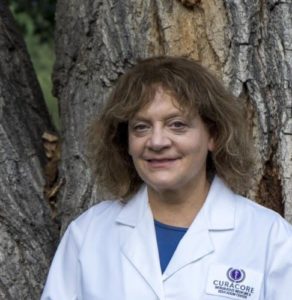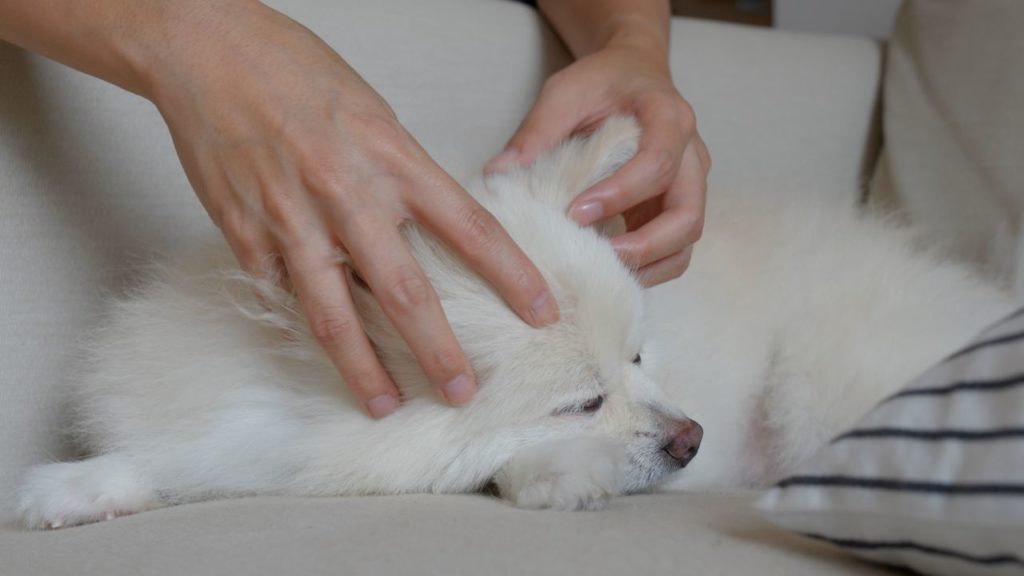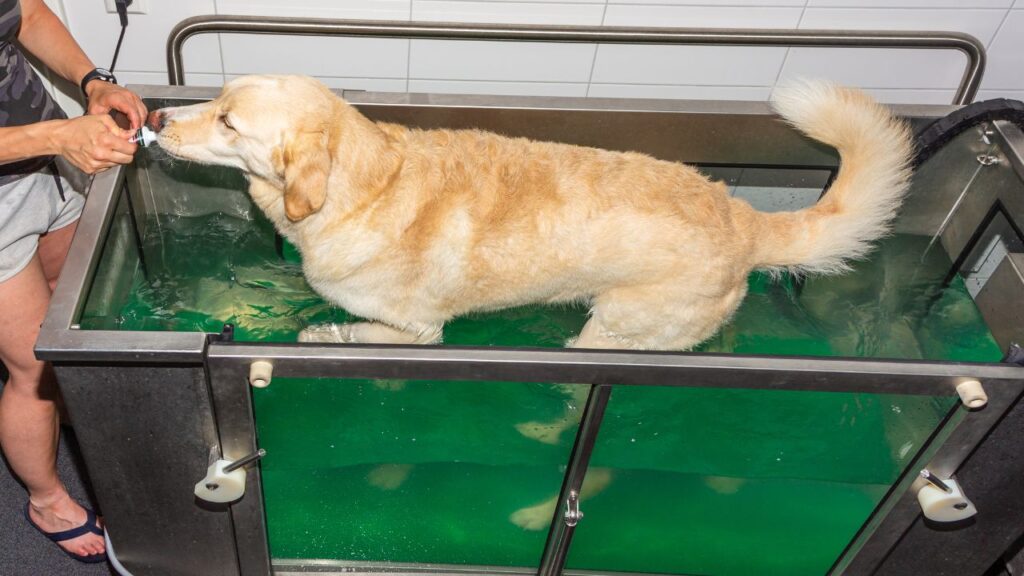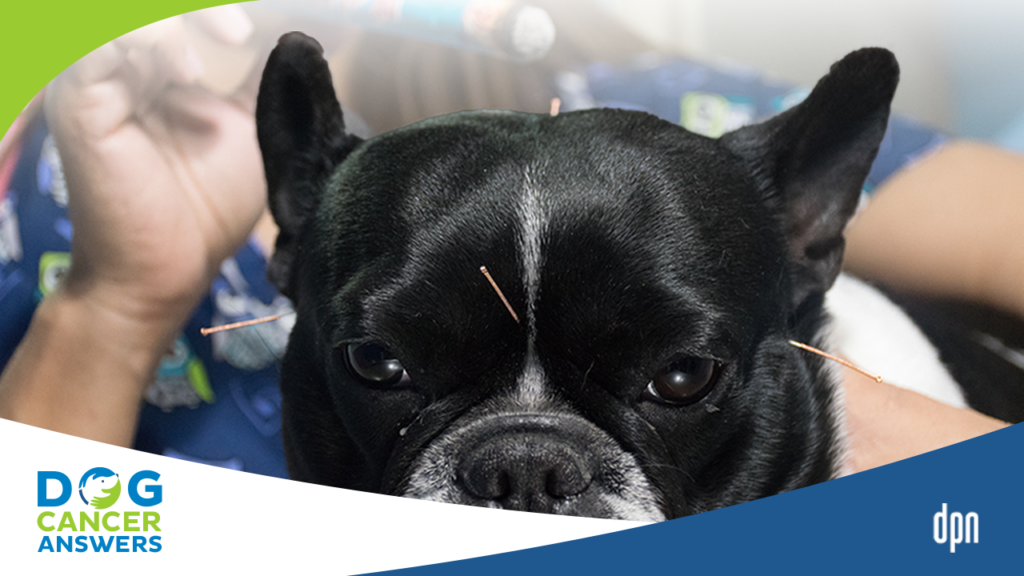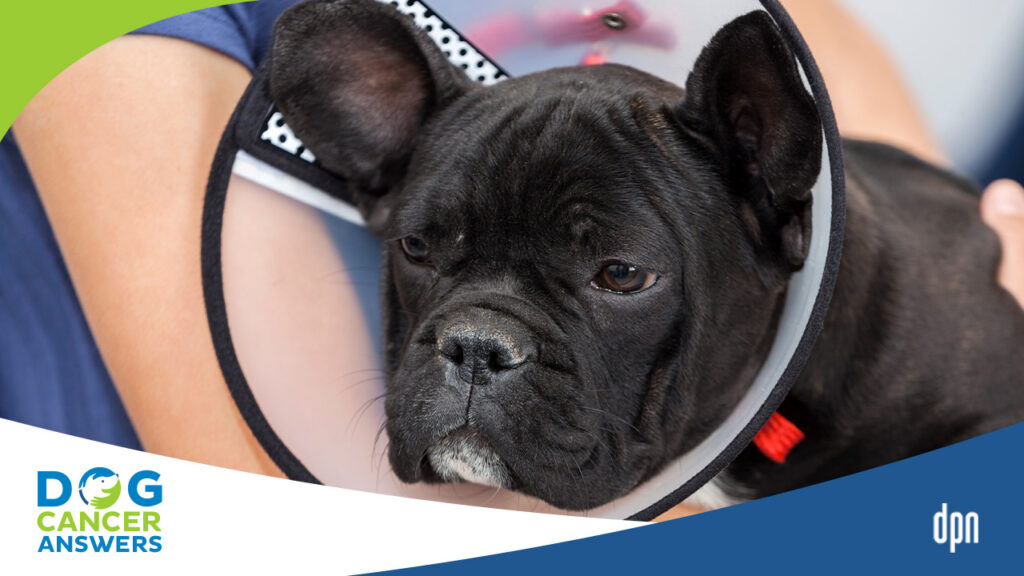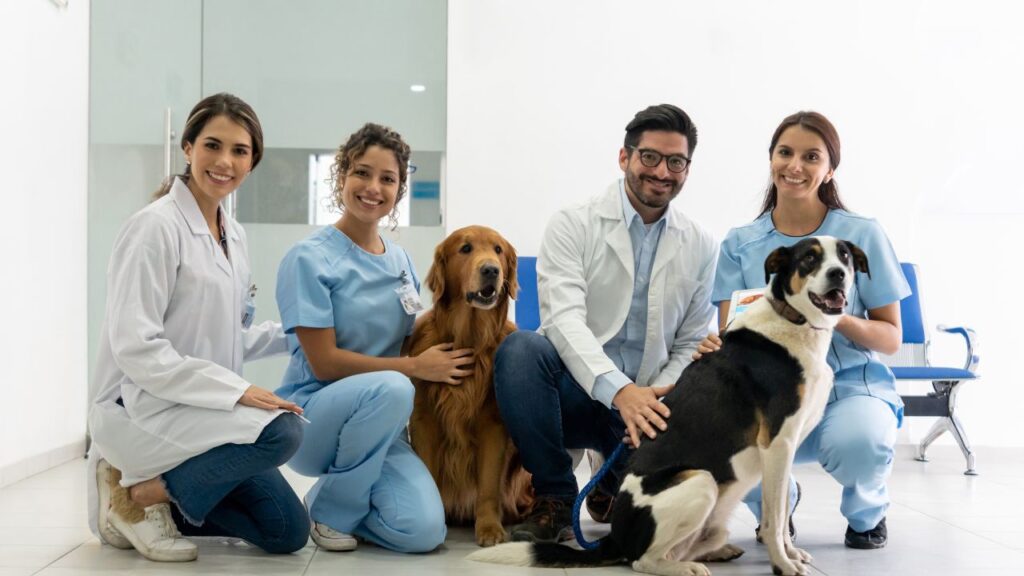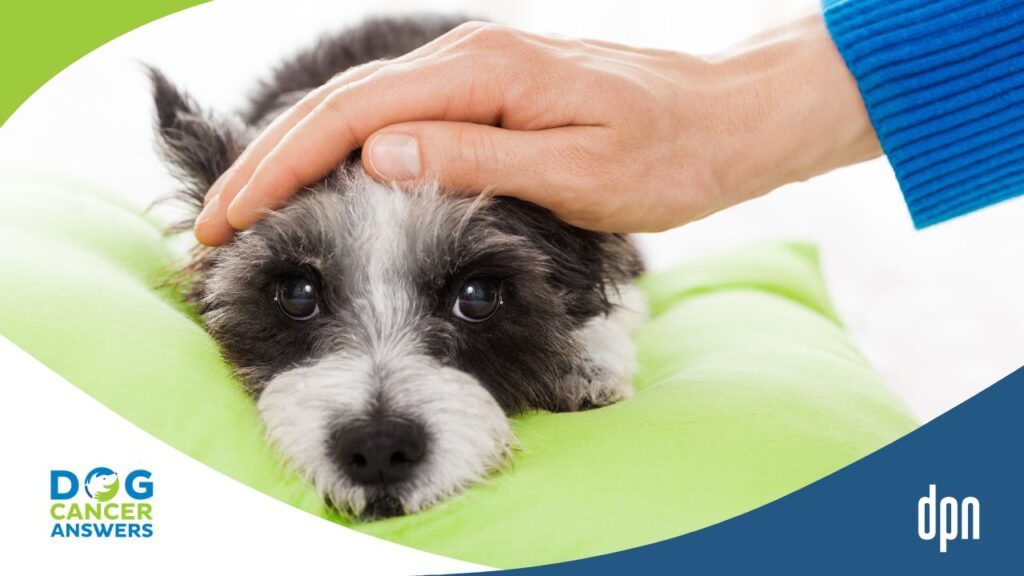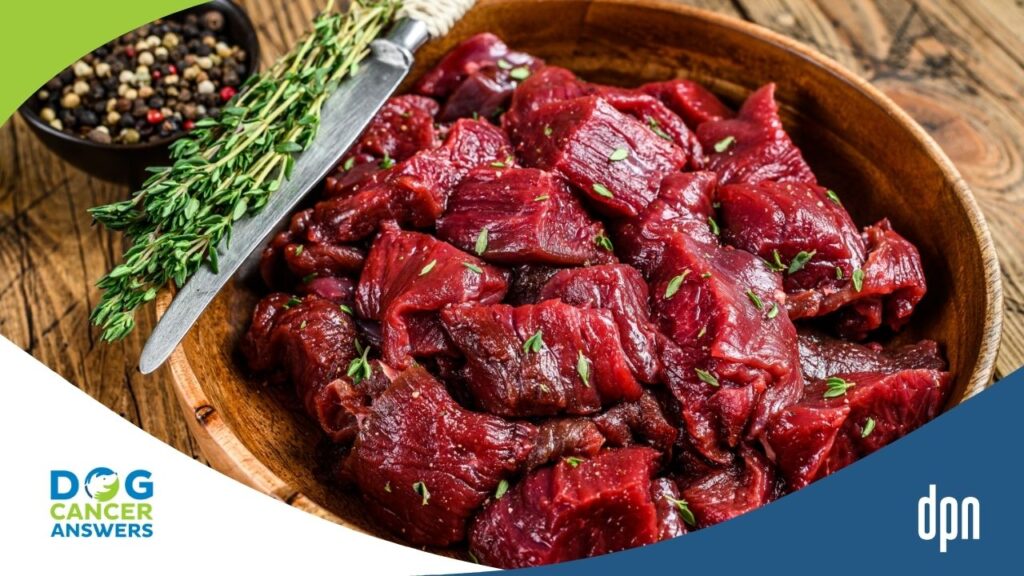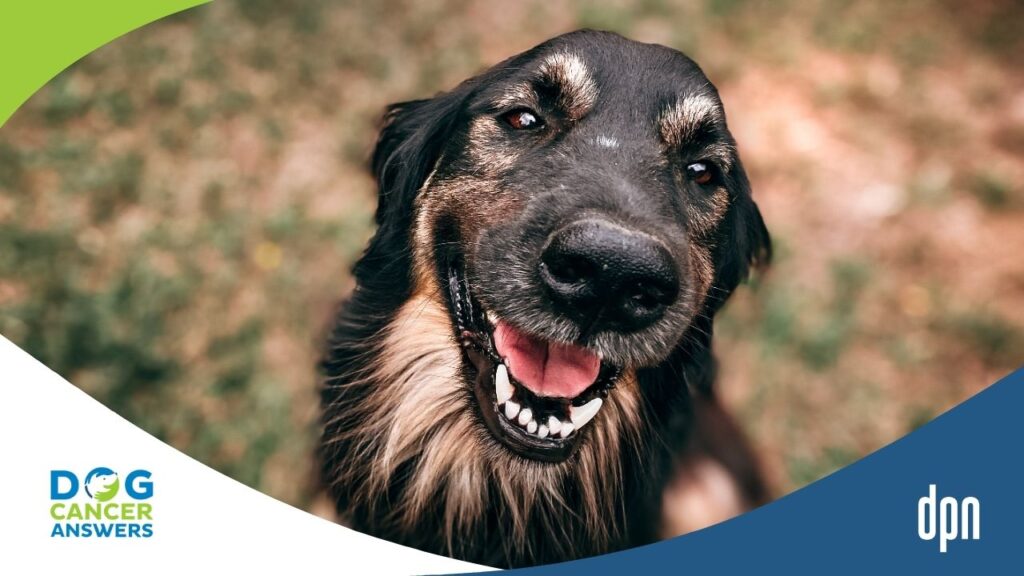EPISODE 213 | RELEASED April 24, 2023
Medical Massage for Dogs | Dr. Narda Robinson
Massage health benefits can apply to your dog too! Learn the science of how massage helps dogs relax and feel better.
SHOW NOTES
Massage isn’t just about relaxation – it’s so much more. Dr. Narda Robinson is a doctor twice over, and has done massage therapy for both humans and dogs. She explains how massage is all about knowing the anatomy of the being you are working on and paying attention to what you feel with your hands and what your patient tells you.
When is medical massage a good choice for dogs? It can directly benefit patients who are experiencing pain, trauma, anxiety, or even digestion issues. Chronic stress and pain cause a lot of negative changes in the body, and massage can help to relieve that physical and mental discomfort and help get your dog back to feeling good and enjoying their life.
Links Mentioned in Today’s Show:
CuraCore Vet: https://curacore.org/vet/
Canine Massage video: https://www.youtube.com/watch?v=G1zEslSk6Q8
Canine Medical Massage: Techniques and Clinical Applications book: https://curacore.org/vet/bookstore/
CuraCore Find a Practitioner: https://curacore.org/vet/find-a-practitioner/
[00:00:00] >> Dr. Narda Robinson: We were working with those patients and partnering, and in Latin, doctor means teacher, and so teaching them how to deal with life and help themselves and be part of a social ecosystem that’s healthy for them, so making the right choices.
[00:00:18] >> Announcer: Welcome to Dog Cancer Answers, where we help you help your dog with cancer.
[00:00:25] >> Molly Jacobson: Hello, friend. I’m Molly Jacobson, and today on Dog Cancer Answers, we’re diving into a topic near and dear to my heart: medical massage. Massage won’t cure your dog’s cancer, but it can do wonders for their comfort and life quality. And isn’t that what we all want?
To explain how massage can benefit your dog we are once again joined by Dr. Narda Robinson. Dr. Narda is both a veterinarian and an osteopath, and she’s also the author of the book Canine Medical Massage: Techniques and Applications.
Dr. Narda, thank you so much for coming on the show again.
[00:01:00] >> Dr. Narda Robinson: I’m so happy to be here. Thank you for inviting me.
[00:01:02] >> Molly Jacobson: Well, we are just so pleased, and I wanna make sure that our listeners know that we’ve got a great episode featuring you on acupuncture as well. And so that to me is a companion piece to this. Not that they’re the same at all, but they’re similar mindsets, something you don’t necessarily think of first when you think of going to the vet, you’re not thinking first, acupuncture and massage. So let’s start there. Do veterinarians learn massage therapy when they go to school?
[00:01:30] >> Dr. Narda Robinson: No, unfortunately, not yet, unless they would enroll in a program, you know, concurrently outside of the veterinary school. When I was teaching at CSU for 20 years, I would, I mean, I had integrative medicine classes. I had an evidence-based herbal medicine class, but we’d often have get togethers at night and I’d teach them massage and just the basics of acupuncture needling.
And in one enlightened year, I mean just when the powers that be came together, I actually taught the freshman students myofascial palpation. So identifying areas of restriction in the soft tissues, so the muscles and fascia of animals and how you link that with changes in mobility and posture and all that. And they just loved it, but just things kept on changing and you know, there’s always more surgery to teach, so why would we spend time with that? So.
[00:02:28] >> Molly Jacobson: From your perspective, why would it be good to spend more time with that?
[00:02:33] >> Dr. Narda Robinson: Well, to tag onto that, right before I left CSU, I had proposed and it was accepted to create four years of an integrative and integrated, you know, medicine program so that, for example, with relationship to massage, that when they’re learning anatomy, wouldn’t it be much more relevant, clinically applicable, interesting, engrossing, deeply educating to have awareness of the muscles, not just origin and insertion and innervation and all that, but actually feel them on an animal.
So learn them however you’re going to, whether it’s with modeling with clay, dissecting a cadaver, using a virtual canine anatomy kind of thing, but take that information that your brain is trying to encode in your hippocampus and all that, and feel an actual dog or cat or horse.
[00:03:36] >> Molly Jacobson: Right.
[00:03:36] >> Dr. Narda Robinson: And understand how that anatomy, so the muscular anatomy and the fascia enveloping it and infusing with it, how that changes from health to disease states so that when you’re actually treating animals, that you can palpate them and find out where is the pain. Let’s localize it to the tissue, to the anatomic location. Characterize it. Is it inflammation? Is it a trigger point? Is it neoplasm? So a tumor in the bone or something. There’s such a loss of hands-on education and real practical information that you can translate to be a better doctor.
That it could start with learning the anatomy of acupuncture plus massage, right in your first year. And then my proposal was, yeah, botanical medicine with pharmacology and you know, just like the autonomic nervous system, so the fight or flight and how we could interface with various integrative modalities for even cardiology and neurology.
So anyway, it, it had been approved, but after 20 years it did seem time for me to go. So I started out, that’s when I started CuraCore Vet and uh, CuraCore MED.
[00:04:49] >> Molly Jacobson: Right, right.
[00:04:50] >> Dr. Narda Robinson: And just am doing it on my own without the constraints of a university.
[00:04:54] >> Molly Jacobson: Yeah, that’s a big ship to turn, as they say. Yeah.
[00:04:57] >> Dr. Narda Robinson: Yeah. Good point. Yes, slowly.
[00:05:01] >> Molly Jacobson: Okay, so you mentioned a couple times fascia, and I know myofascial techniques is something that pops up a lot when you talk about massages. Can you talk a little bit about myofascial and fascial and all those vocabulary words people might not be familiar with?
[00:05:18] >> Dr. Narda Robinson: Sure. Yeah. We call it myofascia because myo refers to muscles and fascia refers to the connective tissue, that spider webby material that overlays all, it all keeps all the bundles of muscle fibers together just like in corned beef when you pull apart the slice and you see that spider webby, that’s all fascia, but that’s what you can see. I mean between those muscle bundles, but it really goes down to a microscopic level and then also gathers it all so it’s one unit, but it’s made up of many smaller units and the fascia envelops blood vessels and it’s in nerves.
It keeps the nerves together or else they’d fall apart like custard. So fascia is a big organizing material structurally, but it’s also important for signaling because there are nerves in fascia. There are some vessels in fascia and it helps with regrowth. So when there’s tissue injury, there are fibroblasts within fascia, so those are cells that secrete growth hormones and all kinds of other signaling molecules that keep just the homeostasis of that tissues in the spirit of repair and just balance and all this communication.
You can’t really separate where fascia ends and other things begin for the most part, and if you look at like cross sections of anatomy, like from head to toe, just slices of whoever it is, you see the continuity of fascia from the body surface all the way into the organs and all around. So the fact that we’re focusing primarily, with massage, on muscles, but really vessels and nerves and lymphatics too. It’s the whole gemish.
And not only the outer muscles, but we can influence, to a certain degree, internal organs as well by signaling influences through the nervous system, as well as just, uh, the compressive forces from massage when properly and safely applied, you can influence even digestive function, immune function, a lot of other things.
[00:07:27] >> Molly Jacobson: That’s a really great explanation. A long time ago, I was a massage therapist and I went to school for massage therapy and the way fascia was described to me – in a moment of sort of frustration by a teacher, for some, some of us who couldn’t quite get how profound it was, she said, take every single organ, muscle, bone, everything out of the body and you’re left with a honeycomb you.
[00:07:56] >> Dr. Narda Robinson: Yeah.
[00:07:56] >> Molly Jacobson: And that was a really powerful image.
[00:07:59] >> Dr. Narda Robinson: Right.
[00:07:59] >> Molly Jacobson: Do you agree with that?
[00:08:00] >> Dr. Narda Robinson: Well, I do. I mean, that is a certain type of fascia and connective tissue and, and everything kind of fills in from there. And if anybody’s seen microscope slides of, of tissue, yeah, you have your cells, but skin cells or, or anything else, there is a webbing around there. There are surrounding things and that, those are often fascial tissues. But fascia is part of a bigger sphere of connective tissues. And even if you, when you took everything away and just left the honeycomb, there’s still a bunch of fascia that went in the trash if you took all the other stuff away.
So there’s, there are different types. There’s more your structural stuff that keeps things right and keeps that shape, but there’s also softer, the gelatinous kind of, it morphs into different shapes and it connects and then it disconnects. It’s such fluid material that if you warm it, like when we do laser therapy, you can warm it, and through the principles of thixotropy, I mean, that’s where the water held in the tissue changed from a gelatinous kind of feel to more of a fluid.
And so you can actually feel, even with massage, you can feel the tissues soften, and part of that is how water is dealt with as it’s encased in these connective tissues.
[00:09:15] >> Molly Jacobson: It’s a fascinating substance. It’s like the matrix.
[00:09:19] >> Dr. Narda Robinson: Yeah, it literally is. Yes.
[00:09:21] >> Molly Jacobson: Yeah.
[00:09:22] >> Dr. Narda Robinson: The matrix. Yes.
[00:09:22] >> Molly Jacobson: Yeah.
[00:09:23] >> Dr. Narda Robinson: And still fascinating. Yes.
[00:09:25] >> Molly Jacobson: So obviously we think about muscles relaxing, but you’re saying that it’s not just muscles, it’s also this fascia. How does massage for dogs impact that and what are the real benefits of it?
[00:09:39] >> Dr. Narda Robinson: So massage involves the application typically of your hands, and there’s some kind of a pressure or movement that we’re doing to the body. And so just like we can’t separate fascia from muscles, so we got the myofascia, but those muscles need circulation. So we have blood vessels going through there. And the muscles won’t move if the nerves aren’t working.And then of course, there’s lymphatics that are draining tissues. So, when we even look at what tissues are beneath our hands as we have our hands – here’s Baxter again – as we have our hands – my little.
[00:10:19] >> Molly Jacobson: Your little stuffed animal demonstration dog.
[00:10:21] >> Dr. Narda Robinson: Yes. Um, even as we put our hands on an animal, let’s say I have my right hand on the back of Baxter’s neck, by our knowledge of anatomy, yes, we have various muscles that move the neck and the shoulders, but throughout there, there are vessels, there are nerves that control this area. And then if we come around the sides, like for us, front of our neck, I mean there are vessels there.
So in terms of not only treatment applications, but also safety, it’s important to remember what the anatomy is about. So anatomy is the basis of medicine. And so if there is, when we go through them if there’s muscle shortening, which we could have with overuse, even with non-use. So muscles will work better with regular moderate exercise and some stretching.
So if you had a geriatric dog that wasn’t very mobile, or, or cancer patient, or a young dog that was into sporting and, and overusing and gets some injuries, then those muscles can shorten and the nervous system gets triggered such that it won’t allow the muscles to relax, ’cause there’s just this endless loop coming from the damaged area to the nervous system and then back out from the nervous system saying, contract, contract, contract, shorten.
And so what we can do with our hands is palpate them. So we feel kind of ropey little bundles of the muscles. And best thing to do is palpate them end to end. So if you have, if you’re holding like a tube of a muscle, we’re not gonna go longitudinally along that tube. But if we go 90 degrees to the direction of the muscle, then we can really feel that bundled up feeling. Sometimes if it’s a tiny muscle, it’ll feel like a guitar string.
And the trigger point aspect is when you’re rolling over a taut band like that, it might actually trigger a muscle contraction. And so that’s where it gets really twitchy kind of, or, or that can be a little bit painful. And it also, per human reports, we all have them too.
[00:12:23] >> Molly Jacobson: Right.
[00:12:23] >> Dr. Narda Robinson: It can trigger, yeah, trigger a referred pain pattern. So, just even starting to look at the muscles and, and fascia itself and not even thinking about the rest of the tissues. But there are so many ways that myofascial dysfunction, i.e. trigger points and taut bands, so muscle shortening can cause neck and back pain, any kind of pain. Lameness that’s hard to diagnose where it is without feeling the body.
And again, the tragedy of many decades of where human and veterinary medicine have gone is that lost art of the physical exam, and especially the palpation part, which was probably not fully developed even long ago in terms of feeling the myofascia, feeling the soft tissues so that I can understand who my patient is, where their problems are.
And as I said, we’ve talked about in the past, so that if we can look at an animal, observe the posture, and see how their mobility is and where are they sort of protecting or struggling, where isn’t their stride going as it should, even race horses. You know, I mean it, it’s the whole gamut. It’s all of us.
[00:13:35] >> Molly Jacobson: Right.
[00:13:35] >> Dr. Narda Robinson: That when these muscles shorten, they weaken because they’re already partially contracted, so they don’t even have the force they should have. But then once you have shortened muscles and tissues and you’re all bunched up and like with us, our shoulders are by our ears and all that. Then there’s a loss of good circulation so there’s a lack of oxygenation to the muscles and to the nerves. The nerves get angry because they want their oxygen, and so they’ll start sending pain signals and it’s just not good.
And then lymphatic fluid, the metabolites of our, just the end products of our daily living kind of build up and irritate the nerves so it becomes an endless cycle. So applications are for pain, trauma, immune problems, digestive problems, anxiety, behavior, athleticism. I mean it, it’s the full gamut. Just like in humans.
[00:14:28] >> Molly Jacobson: Yeah. I was just thinking about how, you know, a massage therapist for humans often has to face, especially in America, where massage is not recognized as a modality that can be really therapeutic, they often hear like, oh, well I don’t need to just relax. Relaxing is a big deal actually. You should, when you’re relaxed, you’re healthier, period, and it’s for all of those reasons. The circulation, the better oxygenation.
Your nervous system isn’t firing a mile a minute and sending you into fight or flight and causing all sorts of hormones cascading through your body. Like this is an ad for wellness in general. Everybody should get a massage or learn how to do it, and we should give our dogs massage.
[00:15:12] >> Dr. Narda Robinson: Right, right.
[00:15:12] >> Molly Jacobson: Because they deserve it.
[00:15:13] >> Dr. Narda Robinson: That’s right. And once you start, they want it more and more. Cats too. And if you’re not, you know, trying too hard and pushing too hard. But I would say that, I’m happy to look into the literature and see that massage is becoming more accepted.
[00:15:31] >> Molly Jacobson: Yeah. It’s starting to be covered by insurance companies, which means it’s definitely been showing to help.
[00:15:37] >> Dr. Narda Robinson: Yeah. Right. And with the concern about opioid addiction and.
[00:15:41] >> Molly Jacobson: Yes.
[00:15:41] >> Dr. Narda Robinson: And over-prescribing of opioids.
[00:15:43] >> Molly Jacobson: Right.
[00:15:43] >> Dr. Narda Robinson: You know, patients want massage more than they want opioids, but when you have, let’s say you got an orthopedic surgery and it’s easier to just say, okay, here’s a hundred oxycodone or something that’s gonna just worsen the patient and cause GI, you know, constipation and different things and addiction.
And so same with our animals, and that’s where the vets and the vet techs and whoever else assists in there, I mean, just, just some simple, easy to learn and do and well received techniques can transform an animal’s experience from being scared and painful to being more relaxed in many cases. If, if they’re not, like abhorrent of touch, which is another thing.
[00:16:26] >> Molly Jacobson: Right. So talk about what we can do to give our dogs massage techniques and to apply that in the home environment. Like how do we give our dogs a massage?
[00:16:37] >> Dr. Narda Robinson: Yeah. Well I have done some videos ’cause I had written a book, Canine Medical Massage, a while back, I think 2015. And so the American Animal Hospital Association did record somewhere in the ethers in the, on an AAHA site, there are a series of videos where I’m doing effleurage and some petrissage and compression. So you’d need to see what these techniques are.
[00:16:59] >> Molly Jacobson: It’s hard to do in the audio format. We’ll make sure that those videos are linked to in our show notes. Yeah.
[00:17:04] >> Dr. Narda Robinson: Yeah. Okay. That would be super helpful.
[00:17:07] >> Molly Jacobson: Yeah.
[00:17:07] >> Dr. Narda Robinson: And I am very much in favor of teaching clients how to work with their animals, how to understand what they need, see, feel, and just understand what the animal is manifesting behaviorally or through the body or through your touch of them. And so I would rather teach a client in our exam room and apply techniques and watch them work if they wanted to. But it’s such a rewarding approach and you can detect things earlier. So for example, effleurage, if we’re talking Swedish massage techniques, effleurage is just more of a superficial flowing of the hands on the body.
What people do usually anyways is a kneading of the tissue. So kind of a grasping and pulling, just, you know, rubbing.
[00:17:55] >> Molly Jacobson: That’s petrissage.
[00:17:56] >> Dr. Narda Robinson: Petrissage, yeah. And then compression is another thing where you’re just gently, usually for a limb, you’re holding a limb when they’re laying down on their side, holding it from the bottom and then applying some pressure from above, that would be a nice technique for postoperative conditions of the limbs, and it’s just very soothing.
So, but then you get into when is it good to do massage and when shouldn’t you, or where shouldn’t you do massage, and so when would be the contraindication? So that’s where, I mean, the full gamut of using manual therapy, soft tissue manual therapy as a medical intervention, it’s important to know what’s the quote unquote "dose," but where, how, when not to, blah, blah, blah, so, so it’s not a one size fits all.
[00:18:46] >> Molly Jacobson: Right. Okay. So it’s not a one size fits all. Is there a difference between petting and massage? Do you feel like when people pet their dogs, are they sort of giving them a massage, they’re just not thinking about it that way?
[00:18:59] >> Dr. Narda Robinson: They are, they are giving them a sort of a massage and we often will massage them, I know cats love it around their necks. Dogs do too. Or in front of the forelimbs. So working on the pectoral muscles. And then a lot of times they’ll say, oh yeah, they love their butt scratches and stuff. And so maybe dogs with hip problems will back up into you and they love that. So there are certain areas that people intuitively go to.
But the big missing pieces there that could be filled if we more educate our clients and students and vets and all that is to understand, okay, what am I feeling? So it’s not just doing, but let’s just feel what’s, what’s underneath and how do you know where there might be a tender spot and a problem, and then what do you do there and how might you modify your technique to actually be more therapeutic? And with cats, for example, I know this isn’t a cat thing, but um.
[00:19:57] >> Molly Jacobson: It’s okay.
[00:19:58] >> Dr. Narda Robinson: But cats are often misunderstood and when somebody says, oh, that’s a mean cat, or I can’t touch my cat ’cause she always turns her head and bites me or whatever, those are signs of pain.
[00:20:12] >> Molly Jacobson: Ah.
[00:20:12] >> Dr. Narda Robinson: Sometimes with dogs too, they’ll do that, especially if a Dachshund, for example, had intervertebral disc disease and you went to massage the back, yeah, they might wanna bite you there. Or if they have sort of a spinal cord injury that’s ready to become a bigger problem, they might bite because they are being protective. They know there’s something going on there that like, they don’t wanna be touched and things shouldn’t be jostled much. But with cats, again, when you see a cat that has a hunched back.
Some people might call it roach back, or if you see that their hair coat is really flattened sometimes over their back or, or over their sacrum so their, what we call a tailbone, but they actually have a tailbone, so, so just the place before the tail.
[00:20:54] >> Molly Jacobson: Right.
[00:20:54] >> Dr. Narda Robinson: The hair coat can get flat in dogs and cats, to a certain degree horses. But when that fascia is so tight that it pulls like underneath the skin, pulls that down and it changes the way the hair coat lies. So one of the big things, yeah, one of the big things I teach in my classes for vets and vet students is identify for me hair coat abnormalities. And so many times you’ll find that there are demarcations, there’s lines where it goes from normalish to flat for an area.
Sometimes it’ll be, it’ll be sticking up in an area and it come down the limbs. I mean, just monitoring that, cats are especially expressive with that, but you’ll see so many times when animals have back problems there’s a whole line right down their spine, and that’s all flat, and that’s because that fascia is pulling down.
And that’s a big call to action right there. And as a medical acupuncturist, we know that if we start treating that, then that tissue will start to relax. Oftentimes the fascia will relax in sheets, so the fascia that is covering the whole area there, it can just suddenly, whoa. This doesn’t happen when I treat humans, but whereas you can start to pick up like a bunch of skin like in a puppy, and it’s like, that wasn’t like that before. That was all battened down, stuck down. And now that has changed. And when that changes, there’s much more circulation.
There’s movement improvement, and it’s indicative that the changes are beginning to happen, and then what we’ll often do is a technique called skin rolling if we know massage, and just go with those changes and then further start to work with that tissue to free it up, and it just makes such a difference. And that’s where, if a person is a burned out veterinarian or some other veterinary professional, it’s like you start doing this.
[00:22:48] >> Molly Jacobson: There’s a lot of them these days.
[00:22:49] >> Dr. Narda Robinson: Yeah. You start doing this kind of work though, and you see how the animals love it and the people love it, and that’s what your clinic becomes is animals happy to see you, and they’re feeling better. That is the way to fix this whole burnout, depression thing, in my opinion.
[00:23:06] >> Molly Jacobson: Hmm. That’s an excellent prescription.
[00:23:08] >> Dr. Narda Robinson: Thank you.
[00:23:09] >> Molly Jacobson: Yeah. Make everybody happy and get them back to just the physical joy of being in a body, ’cause a body that feels good is a joy. It makes your life a better life. No matter what else is going on.
[00:23:23] >> Dr. Narda Robinson: Right. And when we think of the amount of drugs that are pushed for vets to prescribe – so coming from a more natural integrative medicine perspective and knowing the potential for all these therapies when properly performed and scientifically based to help an animal profoundly and to maintain their health, then we see how many drugs and surgeries were not needed, and that probably didn’t work that well anyways.
So when we think about the applications for massage for anxiety, behavior problems, movement abnormalities, pain, digestive things, if we had massage coming in there, then you can think of all the medications that these animals are given for these same problems. I mean, it even has anti-inflammatory benefits. And then when we can get them up and moving better, then even the exercise and the movement is intrinsically anti-inflammatory, pro circulatory, you know, mind and mood uplifting, things like that.
So the bigger message is transforming the bad habit patterns that medicine has gotten into which seems to think that a body is a vat of chemicals. And let’s add more of this. Let’s add more of that. Or cut this, or cut that. Instead of more like the mindset of cultivating a garden where there’s health and we nourish the soil, make that stronger, give all the nutrients we need, and the exposure to fresh air and just nature itself, and that we can be healthier. But there’s not as much money to be made in the massage world as there is in pharmacotherapeutics.
[00:25:02] >> Molly Jacobson: That is definitely true. And the veterinary medical education is an expensive one, and there’s a lot of problems from top to bottom, right, that you can’t necessarily solve overnight.
[00:25:13] >> Dr. Narda Robinson: Yeah.
[00:25:14] >> Molly Jacobson: But I agree with you that the nurturing, uh, thinking of the body as a garden is a lovely way to think about it. What are we doing to nurture the soil so that everything is healthier. Okay. Let’s pause here for a short break and then we’ll be back with Dr. Narda Robinson. And I wanna ask you about when not to do massage.
And we’re back with Dr. Narda Robinson. You mentioned before, there are times not to do massage, there are also places not to do massage. So just so that our listeners can get that in their minds, when do you recommend avoiding and what do you recommend avoiding?
[00:25:56] >> Dr. Narda Robinson: Well, especially for dog cancer, we don’t want to massage a tumor.
[00:26:01] >> Molly Jacobson: Okay.
[00:26:02] >> Dr. Narda Robinson: So we wanna be very careful with that. If there was bone cancer, then we need to be very careful if there’s a tumor in the bone. So anywhere that could break, like a neoplastic bone or after a fracture. If an animal has a lot of infectious diseases going on, whether that’s, uh, maybe it’s a drug resistant staph infection, so then that’s the person, as a practitioner, you always wanna have your hands washed and make sure you’re not transmitting disease from one patient to another, right?
And I mean to a certain extent, like tissue fragility. So if they’re on a lot of anti-platelets, so blood thinning medications, if they’ve been on steroids for a long time, has that weakened their skin and their other tissues. So that’s again the difference between somebody just picking up a book and learning at home versus taking a whole course. Whether your education prior to that is being a veterinarian or a vet tech or, or a massage therapist or whatever. I mean, there’s a lot of physiology and pathology and just when to do what involved in that.
So I think for people then they should talk with their veterinarian and see if they can get some advice on that. And even so, when we do have varieties of practitioners out there doing therapies, you know, there’s still risks even if you are a professional doing massage. Like I’ve had patients where human practitioner tried to apply the amount of pressure that they do and the style of technique that they do to a dog and actually cause injury. I mean, several times that’s happened.
So the animals need so much less force typically for at least dogs and cats. So there are guidelines for sure. And that’s where, yeah, that’s where my opinion, the veterinarian should have an education in these things and be able to discern who’s the right adjunctive practitioner, if they’re gonna have one, and who’s the right patient and how often, and really reading the animal and, and how’s the animal doing during this too.
[00:28:10] >> Molly Jacobson: Really paying attention to the signals the animal’s giving you, which is usually they’re pretty clear. That feels good, or I don’t like that. Like if they get up and walk away, it was either too much or for too long.
[00:28:24] >> Dr. Narda Robinson: Right.
[00:28:25] >> Molly Jacobson: And that goes for petting too, right? Like.
[00:28:27] >> Dr. Narda Robinson: Oh, absolutely.
[00:28:28] >> Molly Jacobson: We don’t need to keep petting our dog just because we want to keep petting our dog.
[00:28:31] >> Dr. Narda Robinson: Right, right.
[00:28:31] >> Molly Jacobson: If the dog doesn’t, no longer enjoying it, leave them alone.
[00:28:34] >> Dr. Narda Robinson: That’s absolutely right. Yeah, and it’s not about how many minutes you do, it’s about were you effective or not. And exactly like you’re saying, did they tolerate it? And when they’re done, that, it’s done or else you’re going to be worsening things again. So you have to really pay attention.
[00:28:50] >> Molly Jacobson: It’s so interesting to me. You know, so many of our listeners I know will resonate with this. I certainly have felt this as a, a dog mom of a dog with cancer, that the urge to fix it is so, so strong and you think, oh, this is working, this is helping. I’m gonna do more. And then you do too much. Doesn’t matter what it is. It could be too many supplements, too many, you know, getting too involved in dietary changes and like getting really, really granular and like obsessive about it.
Like we wanna fix the problem. So we often will transfer that to whatever thing that is supporting our dog and think, well, if one supplement’s good, then 10 must be much better. And maybe if one dose seems to be helping doubling it will – and it’s not true. It’s not true.
[00:29:36] >> Dr. Narda Robinson: No.
[00:29:37] >> Molly Jacobson: Enough is enough.
[00:29:38] >> Dr. Narda Robinson: Well, it it is. And it requires those of us that are in that situation to be in touch with our own inner compass and be receiving information and not just on output all the time. So, I understand people can be stressed and fearful and want to do the most, but that actually, that state of mind doesn’t feel good and so, just even again with, with those that I teach, it’s not only about what we’re teaching and the subject, but it’s about how are we living, how are we being in our profession, and who are we that we’re bringing to our patients and to our clients?
Just like when I was in medical school and planning at first to be a neurosurgeon and doing the different activities and rotations of fellowships in that versus when I found out about acupuncture and I was already an osteopathic physician, so I already, part and parcel of that is working with your hands. But just at the end of the day, how did I feel about what I did?
So from cutting or putting pacemakers into the spinal cord and all that and dealing with patients we were doing things to versus acupuncture, manual therapy and, and that kind of more integrative approach, we were working with those patients and partnering. And in Latin doctor means teacher, and so teaching them how to, you know, deal with life and help themselves and be part of a social ecosystem that’s healthy for them.
So making the right choices. And so for me, I felt still whole pretty much by the end of the day in that scenario of the acupuncture, manual therapy, family medicine kind of thing, versus as neurosurgeon, yeah, it’s kind of cool to dig into things, but after a while, just cutting tissue, burning tissue made me feel like really bad.
[00:31:30] >> Molly Jacobson: And that’s a signal to you.
[00:31:31] >> Dr. Narda Robinson: Yeah.
[00:31:32] >> Molly Jacobson: When you feel really bad, it’s not a good situation. That’s a really interesting, I think that’s a really profound tip for our listeners. Because that is something that we come back to over and over again as a central guiding message, that the relationship with our dog is the reason why we’re even thinking about treating cancer in the first place. Because there are many people who choose not to treat cancer at all, and it’s not because they don’t love their dog.
It’s because, usually it’s because they don’t wanna put their dog through it, or they have financial considerations that make it impossible. There’s a million reasons. But when we are treating cancer, the reason we’re doing that is because we wanna have this dog around for longer because they’re part of our lives and we love them. And they love us. And so if we ever feel out of touch with that love and that calm, connected feeling, then we’re not actually achieving our goal in treating cancer in the first place.
[00:32:27] >> Dr. Narda Robinson: Right. Right. And we might need help. I mean, when I was working with the Animal Cancer Center – yeah, of course – at CSU, I, I thought here we have all these clients waiting to be seen in oncology and wouldn’t it be wonderful if all these individuals in the waiting room had a forum to talk to each other to share their stories, their tips, you know, root each other on? I just thought that was a really important next step.
[00:32:55] >> Molly Jacobson: Yep. And that’s what we hope to be building in.
[00:32:58] >> Dr. Narda Robinson: Yes.
[00:32:58] >> Molly Jacobson: Yes.
[00:32:59] >> Dr. Narda Robinson: That’s right.
[00:32:59] >> Molly Jacobson: And we’re really glad you’re a part of that.
[00:33:01] >> Dr. Narda Robinson: Thank you.
[00:33:01] >> Molly Jacobson: Because you’re an important voice. So people can ask their own veterinarian, or they can go, I imagine, to a veterinarian who specializes in rehab, because they would typically know how to do dog massage. Is there a course or something they can take online or is there a school for dog massage for the layperson?
[00:33:18] >> Dr. Narda Robinson: There are various schools. I mean, I, I have taught massage. We did start at CSU in 2009 and we have a, a yearly course, but it’s for veterinarians and veterinary technicians, so canine medical massage. There are various canine massage schools, so I’m sure people could find something.
[00:33:35] >> Molly Jacobson: Okay.
[00:33:36] >> Dr. Narda Robinson: I mean, there are some that, in addition to teaching treatments with your hands, they might get into psychic communication and.
[00:33:45] >> Molly Jacobson: Oh, okay. So it depends on how woowoo you wanna get it.
[00:33:48] >> Dr. Narda Robinson: It’s the degree of woowoo because, yeah, because, it’s cool if you think that your dog doesn’t wanna take any more phenobarb for the seizures, but was that accurate? And if you say, my dog told me to take him off of phenobarbital and all other medications and just do homeopathy, well, can’t say that the dog didn’t say that, but maybe the dog doesn’t know the consequences of that.
I mean, you know, I, I’ve just been around for so long and I practiced in Boulder for many years, so, human medicine. Anyway, so there are schools that run the gamut, but I think just have discernment. And my preference would be go to a place that teaches you anatomy, that doesn’t teach you quasi-chiropractic, so boom, boom, you know, moving the animal’s neck around suddenly.
Yeah. And people can contact me if they have any questions, but you know, just really grounded foundational treatments that are cued into what the animal is saying, which even a lot of vets don’t know, so, so these are things we teach vets in our courses. When we’re doing palpation and the animal blinks or licks their lips or yawns, they’re not yawning because they’re tired and you’re making ’em go to sleep. They’re yawning because they’re stressed. So these are signs of stress. When you’re palpating, you might be using too much digital pressure, so you’re sticking your fingers into it, ’cause that’s how many vets were taught to palpate. Stick your fingers into the animal and see what happens. I know, I know. It’s terrible. Sorry. So.
[00:35:15] >> Molly Jacobson: As a massage therapist, I object.
[00:35:18] >> Dr. Narda Robinson: I object as, as an everything, as a human being. But um, yeah, that’s why I’m always saying flat hand palpation, blend with the tissues, and, and feel the contours of the muscle. And then when you’re on something and they’re looking at you and they wanna move, I mean, that’s just basic signals that the animal is saying to you, well, before they want to bite. They might never wanna bite you, but you’re hurting them maybe.
So, whatever it is, like improving our communication, not psychically, but our interpersonal communication with these family members that speak a different language is so paramount to that relationship. Whatever we’re doing. That dog in the background agrees.
[00:36:02] >> Molly Jacobson: Chloe agrees. Completely.
[00:36:05] >> Dr. Narda Robinson: Emphatically.
[00:36:06] >> Molly Jacobson: Emphatically. Yes. Okay. All right. Funny. Yes. Well, that is an interesting point. As a massage therapist, one of the things that was drilled into us – that’s the wrong word, softly suggested over and over again, was that we had to be relaxed in order to give a good massage. If we had any of our own stuff going on, we could not do a good massage.
And if you’ve ever gotten a massage from someone and felt like they were sort of distracted or stressed out, when you touch someone else, you are not only feeling what’s going on for them, but they’re feeling what’s going on for you through your hands. And a soft gentle hand like, the way I like to think about it is like when you’re holding a baby and you cradle their skull, you don’t squeeze.
[00:37:01] >> Dr. Narda Robinson: Yeah.
[00:37:02] >> Molly Jacobson: Right?
[00:37:03] >> Dr. Narda Robinson: Right.
[00:37:03] >> Molly Jacobson: And you don’t let your hand go loose. You sort of just gently hold. And that, I think if you treat your, your dog, and your cat and your other animals and your loved ones, all of your loved ones, humans too, like a baby, like just treat them like babies and that will give you the right feeling of like how to touch someone else of any species. But it’s such a profound way of communicating, and I think you’re right that a lot of us miss pain signals and some of the things you just said are really important.
So are there other things that we might miss that our dogs are trying to tell us? Other signals that people don’t know about?
[00:37:45] >> Dr. Narda Robinson: Well, I think that reading the body are other signals. So you see this all the time with dogs especially, that their head is down and it might not even come to, I mean, it might just be right along the line with their back instead of angling up and that they’re looking around. And when they’re doing that, that is often a sign that their neck hurts.
[00:38:08] >> Molly Jacobson: Ah.
[00:38:08] >> Dr. Narda Robinson: And for veterinarians and masseuse to not know that, it’s like, okay, well maybe they have hip arthritis on the radiograph, and so we’re gonna do all kinds of things for the hips, when actually it was their neck that was a problem. Then we have to see, was it muscular, was it neurologic, whatever. But just that head down kind of thing.
And if you give them a biscuit from you standing up and like, they might not wanna raise their head, it’s like if the back of our head hurts or we have a bad headache in the back or of the head or, or the neck, you don’t wanna just move your head all the way around. You hold it stiffly, and if you turn, you turn with your whole body and neck, you know, fixed. You don’t just rotate your head.
So watching the posture and the movement are so key. And again, like I mentioned with cats. Is the back arched in places? Is it sunken in places? What’s the movement of the tail? What’s the expression on their face? What are their ears doing? You know, what’s the dilation of their eyes? Just like with horses, the importance for your life of reading their behavior, of seeing the signals and attending to them.
But like you were saying, when we’re all distracted, in our own world, we’re not paying attention, that’s when veterinarian or somebody around those large animal or even a cat, whatever you get, you can get hurt ’cause you haven’t been picking up those signals. And um, we taught a course at Michigan State a few weeks ago and um, one of the equine practitioners said that she fears cats.
Now, I’m not saying you should fear cats. But she thinks a cat could be more dangerous than a horse, ’cause she’s used to being around a horse. Like the cats are quick. But me as a cat person, I’d say you just have to, you have to treat the cat, you know, like the royalty that they are, and understand, understand, you know, what’s going on for them.
And so if we love animals, let’s invest in getting to know their bodies and minds from ways that haven’t been traditionally in conventional medicine been conveyed. And just also a note about your own presence of mind, heart, soul, body, when you’re interfacing either with a patient or another being, that that’s where another challenge is in veterinary medicine. So if they’ve just done a euthanasia or they’ve had a bad outcome or, or a client.
[00:40:27] >> Molly Jacobson: Right.
[00:40:27] >> Dr. Narda Robinson: You know, it’s just so stressful, which is why I don’t do that kind of medicine. I would not survive that kind of medicine. So I just need to be in a bubble where it’s more spa-like and everybody’s happy and, uh, let’s take care of each other. And so to practice, oh, massage, let’s do massage and acupuncture, and then do whatever else, it’s like that, that does not jive well. So what people end up doing when they learn this is schedule your general practice in another room, in another location on another day.
And then it’s just important to be in this space. And like I said, with neurosurgery versus acupuncture, there was something left of me at the end of the day and I, I felt whole still versus, I don’t know, just empty and whatever. So.
[00:41:16] >> Molly Jacobson: Ready for a drink.
[00:41:18] >> Dr. Narda Robinson: I guess. Yeah.
[00:41:19] >> Molly Jacobson: Yeah.
[00:41:19] >> Dr. Narda Robinson: But it comes back to what do we want to do with every day that we’re alive? I mean, we don’t know what’s gonna happen, and I chose, I want to be in this good state of mind, happier every day than say, oh, I’m a neurosurgeon. So what? Put people on ventilators. Yeah. You know, I’d rather – and so then I went to veterinary medicine, it’s like, yeah, because I couldn’t deal with not being a veterinarian also, even though there was a lot of sadness to deal with it. And so then I found my bubble of integrative medicine where I can just do things that animals enjoy and I enjoy.
[00:41:54] >> Molly Jacobson: That’s wonderful.
[00:41:55] >> Dr. Narda Robinson: Thank you.
[00:41:55] >> Molly Jacobson: So what do I look for? My last question is, when I can’t go see Dr. Narda Robinson with my dog, what am I trying to discern in the veterinarians in my area? Like who am I looking for? What credentials might they have? What are the signs that I’m gonna get a good rehab slash massage therapy acupuncture type vet?
[00:42:17] >> Dr. Narda Robinson: Well, we have graduates from our program, but there’s not as many as through our medical acupuncture for veterinarians course. I think that in general, the thing is that how much a veterinarian or veterinary technician that learns rehabilitation and has gone on, even a board certified veterinarian in rehab and sports medicine, they might not actually have gotten a lot of massage training.
[00:42:43] >> Molly Jacobson: Okay.
[00:42:44] >> Dr. Narda Robinson: So it will be variable. They know, might know something about it, but that’s where the ideal thing is to have professionals around you that have really dedicated their time and study to animals if they’re coming from the human profession. So yeah, I went all through vet school in addition, but we teach our rehab course with a physical therapist who has been in animal physical therapy since like 2004, 2006, and she studies all the time.
And so she is so gentle and knowledgeable that I would refer to her any time. I mean, we have her as a main faculty member in our course ’cause she’s so knowledgeable and there is something to be said for being a human practitioner and then adding on animal applications. But really there’s a responsibility to very much understand how the two differ and how to approach an animal.
So it might be that there’s a massage therapist around that has studied quite a bit of canine massage and is working with veterinarians because, I don’t know. I would want them to be very connected to the veterinary world also and not just kind of out on their own.
[00:43:59] >> Molly Jacobson: Right.
[00:44:00] >> Dr. Narda Robinson: And I would say be there. Maybe meet them, watch them work. Especially be there when your animal is being treated and how do you feel that person is relating to what your dog is saying and the dog, same thing. And in fact, in our massage course, I co-teach that with a massage therapist, Rhonda Reich, who was the originator of canine massage decades ago.
[00:44:24] >> Molly Jacobson: Okay.
[00:44:25] >> Dr. Narda Robinson: Through the Boulder College of Massage Therapy.
[00:44:26] >> Molly Jacobson: Okay.
[00:44:28] >> Dr. Narda Robinson: So just like with my rehab course, I have brought a human practitioner in, Rhonda Reich and, um, I mean, she’s fantastic. She’s so from the heart, which is not usually that much from veterinarians, but she’s just all present in, in the heart space and, you know, has decades of techniques and she’s taught human massage and veterinary massage with me. So I really see an opportunity for collaboration, but it’s not gonna be one size fits all and practitioners differ in their gentleness or aggressiveness. So you gotta know who you’re dealing with.
[00:45:02] >> Molly Jacobson: And they at the very least need to understand the animal anatomy as well as they understand the physical anatomy because you can hurt your clients as a massage therapist. There are places you should not even touch, let alone massage.
[00:45:16] >> Dr. Narda Robinson: Right, right. And same with animals. And you can hurt them.
[00:45:18] >> Molly Jacobson: And the same with animals. Yeah. Yeah.
Well, thank you so much for joining us. I know we will be talking to you again in the future because you’re always such a pleasure to have on and you bring such a, a different perspective and, um, such a heart-centered one. And we really appreciate you in every way, Dr. Narda Robinson.
[00:45:39] >> Dr. Narda Robinson: Oh, thank you. Same here with you. You’re my favorite podcast to be participating in, so, yeah.
[00:45:44] >> Molly Jacobson: Oh, thank you.
[00:45:45] >> Dr. Narda Robinson: Thank you.
[00:45:48] >> Molly Jacobson: And thank you listener. Obviously, we all love to pet our dogs and our dogs love to be pet. And massage for dogs is similar but done with more intention. And as Dr. Narda Robinson points out, more knowledge. So getting a massage therapy professional, whether they’re veterinarians or human practitioners who have deep knowledge of canine anatomy to help you is really, really useful. Now, obviously, as long as you’re not poking at your dog and you’re using a flat, firm, but gentle touch, your dog’s probably gonna enjoy it.
But remember, massage can really help. It’s not just about relaxation. It’s about all the things because that fascial connection in the body interfaces with every body system, with the nerves, with the blood vessels, with the immune systems, with signaling messenger chemicals that zip around the body and tell it what to do, all of that can be impacted through the fascial connective tissues. So it’s powerful and potent and something to keep in mind next time you’re touching your dog.
To learn more about massage and all sorts of other integrative medicine techniques, which is what we’re all about, go to our website dogcancer.com. You will find lots of information about integrative medicine which, in our worldview, includes all of the conventional tools because anything that helps our dogs can be considered part of integrative medicine no matter where it comes from.
I hope that you and your dog enjoy a cuddle today. I’m Molly Jacobson, and from all of us here at Dog Podcast Network, I’m wishing you and your dog a very warm, Aloha.
[00:47:39] >> Announcer: Thank you for listening to Dog Cancer Answers. If you’d like to connect, please visit our website at dogcancer.com, or call our Listener Line at (808) 868-3200. And here’s a friendly reminder that you probably already know: this podcast is provided for informational and educational purposes only. It’s not meant to take the place of the advice you receive from your dog’s veterinarian.
Only veterinarians who examine your dog can give you veterinary advice or diagnose your dog’s medical condition. Your reliance on the information you hear on this podcast is solely at your own risk. If your dog has a specific health problem, contact your veterinarian. Also, please keep in mind that veterinary information can change rapidly, therefore, some information may be out of date.
Dog Cancer Answers is a presentation of Maui Media in association with Dog Podcast Network.
Hosted By
SUBSCRIBE ON YOUR FAVORITE PLATFORM
Topics
Editor's Picks
CATEGORY
